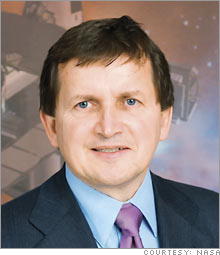A Microsoft legend's next great adventureCharles Simonyi's Intentional Software is making software that writes its own code, easing technical burden and reducing human error.(Business 2.0 Magazine) -- This fall the business world will see the first tentative release of a product that Charles Simonyi has been working on, in one form or another, for most of his professional life. No, it's not word-processing software, which the Hungarian immigrant developed at Xerox PARC and then took to Microsoft in 1981, and which helped build him a fortune estimated at $1 billion. It's more audacious than that. Simonyi's five-year-old startup, Intentional Software, is making software so smart that you can simply tell it what you want to do. Lay down a few basic parameters, and it will write its own code. No programming skills are necessary.
 "Experts [in other fields] can be much more innovative and responsive to their business, and see the resulting software immediately," says Simonyi, speaking from the deck of his yacht, one of the world's largest. Humans, arguably, have done a pretty lousy job of writing code. Derailed software projects have shamed plenty of large companies. (See "When Bugs Attack," right.) The National Institute of Standards and Technology says such bugs cost the U.S. economy nearly $60 billion each year. "The nature of programming is that you make mistakes," says Jonathan Edwards, a research fellow at the MIT Computer Science and Artificial Intelligence Lab. "No one ever gets it right, and people have concluded this is as good as it's going to get." Not Simonyi, who has always believed that software should do the heavy lifting for people. After all, we were staring at command-line prompts on green screens until he and his fellow Xerox (Charts, Fortune 500) engineers came up with the graphical user interface. At Microsoft in 1995, after building the entire Office suite, Simonyi tried to go one level of simplicity further, with the programming equivalent of point-and-click. The project became an obsession and, seven years later, a startup. Simonyi threw out his code and started from scratch twice before he was satisfied. (He also found time to take a $20 million jaunt on the International Space Station in April.) Intentional's technology centers on the Domain Workbench, a human-language and graphically friendly representation of the software as it's built. Much as blogging platforms like Blogger and TypePad gave millions of Web surfers the power to publish their own sites while ignoring all that pesky HTML code, the Domain Workbench would hand enterprise software design to businesspeople. Here's how it works: Users write clear directions in text, spreadsheet, or flowchart-like forms describing what the software should do. In some cases, they can use an interface where lines are drawn between boxes and documents to establish the relationships and rules that an application must follow. The information is sent to a code generator, which spits out the thousands of lines necessary to build the application. Intentional users must still have a software engineer on hand to help set up the programming language and to tweak it anytime a variable changes. Henk Kolk, CTO at Capgemini, a Paris-based IT services firm and an Intentional client, says Domain Workbench is a godsend. A project that would previously have required 50 programmers working for five years, he estimates, could be completed with Intentional in "just a couple of months." Kolk is running three pilot projects using the system, and this fall Capgemini plans to release a Domain Workbench aimed specifically at its pension firm clients. "We created a domain language for the pension world that is immediately understood and usable by those experts," Kolk says. "I'm a believer that businesspeople should be able to express what they want to do and generate software directly from that." There's a healthy dose of skepticism in the programming community that Intentional will accomplish its goal. IBM (Charts, Fortune 500) and Cornell set up similar systems that were shunned by programmers. And MIT's Edwards is dubious of Intentional's attempt to patent its system in an age when open-source rules. "It feels archaic, frankly, to have all of this secrecy, the patents and NDAs," he says of Intentional, which has thus far released few technical details. "The only way you have an influence today is by giving it away." Simonyi says he's "willing to take the risk" that owning the platform may slow its adoption. He's betting programmers don't enjoy working on the business aspects of software development - pension rules or HIPAA legislation, for example - and "will be delighted by the separation from the drudgery." Some programmers agree. "Software's job isn't to be well written and cool," says Andrew Brooman, a 25-year programming veteran in Florida. "Its job is to solve business problems." If he's right, Simonyi's Microsoft (Charts, Fortune 500) wealth could be just the beginning of an even greater fortune. |
Sponsors
|

